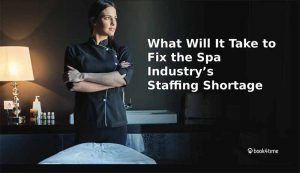
The Moodbeam is a wristband and app designed to track a person’s emotional state and help improve employee wellbeing.
With employers in spa and hospitality struggling to attract and maintain talent, employee experience and wellbeing should be top of mind. A variety of technology is designed to help, including apps, software, and wearables.
The Moodbeam is one tech wellness device that purports to have the potential to help boost employee wellbeing. The Moodbeam is a wristband that links to a mobile phone app and web interface, now available as a standalone smartphone app, with two buttons, one yellow and one blue. Users press the yellow button when they’re feeling happy, and the blue one when they’re unhappy. The device is said to be “a complete solution, helping you map happiness across your people and teams, driving positive change and improved wellbeing.”
Managers can see how teams are feeling in real time
The idea is to allow companies to monitor staff wellbeing now that more people are working remotely. Obviously, you don’t have to be working from home to use it and the idea could work for anyone working from anywhere. Staff would be encouraged (though not required) to wear the wristband and to input their mood data throughout the day. An online dashboard allows managers to see how their teams are feeling in real time, and to open the door for conversations and improvement initiatives.
The wristband technology was a national innovation award winner at the Barclays Entrepreneur Awards in London in 2019.
Moodbeam was founded in the United Kingdom 2016 by Jonathan Elvid, founder of the Gadget Shop and co-founder of Red5, and former journalist Christina Colmer McHugh. McHugh was inspired to create the Moodbeam when her seven-year-old-daughter was struggling at school. She wanted a way to maintain a connection with her child when they were separated throughout the day, but found nothing existed to facilitate this. So, she and Elvid developed the Moodbeam.
“Measure motivation, pain, emotional wellbeing and general happiness”
Today, the website states, “Moodbeam is not only a solution created to help connect parents to their children, but is used by people of all walks of life to measure motivation, pain, emotional wellbeing and general happiness. Moodbeam is also being used by companies big and small across the [UK], helping teams to better understand their teams and make positive changes across their businesses.”
McHugh said in a statement, “The pandemic changed everything when it came to how, where and why we work, and we have adapted our offering in line with that and feedback from users to ensure Moodbeam provides businesses with the best tool possible to add to their approach to staff wellbeing.
“It’s more important than ever that we find new ways of giving staff members a voice, and a method of providing real-time feedback on things in a manner that doesn’t rely on being in the same room.”
The key features of the dashboard allow companies to track the happiness of individuals and teams across multiple locations, view daily “Happiness Scores” for individuals, teams, locations and organizations as a whole, compare the happiness ranking of individuals, teams and locations, and segment people into groups so managers can track happiness across teams or chosen demographics.
“The data collected by Moodbeam’s dashboard can act as a catalyst for positive change. If there is a particular team or location that is tracking a much more positive happiness pattern, the business leader can go in and identify why this is and ideally replicate this across other areas of the business.”
There are many reasons to keep employees happy. One is that happy employees are significantly more productive. Another is that employee attrition is costly and happy employees are more likely to stick around. And happy employees are, of course, also integral to the guest experience which is the key to spa and hospitality success.
Perhaps wearable tech like the Moodbeam will become a contributing factor to overall employee wellbeing and, ultimately, business success.
 Is finding and retaining talent a challenge at your spa? Get insights from industry leaders, including Nigel Franklyn, Lynne McNees, Verena Lasvigne-Fox, and Daisy Tepper when you download our report: What will it take to fix the spa industry’s staffing shortage? .
Is finding and retaining talent a challenge at your spa? Get insights from industry leaders, including Nigel Franklyn, Lynne McNees, Verena Lasvigne-Fox, and Daisy Tepper when you download our report: What will it take to fix the spa industry’s staffing shortage? .
Spa Executive is published by Book4Time, the leader in guest management, revenue and mobile solutions for the most exclusive spas, hotels, and resorts around the globe. Learn more at book4time.com.



